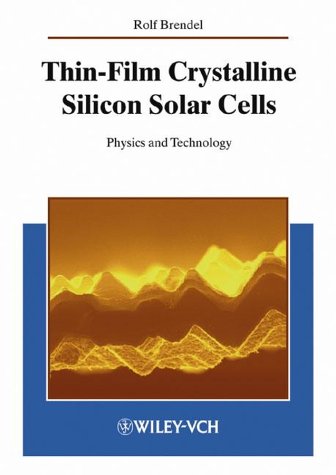

Most ebook files are in PDF format, so you can easily read them using various software such as Foxit Reader or directly on the Google Chrome browser.
Some ebook files are released by publishers in other formats such as .awz, .mobi, .epub, .fb2, etc. You may need to install specific software to read these formats on mobile/PC, such as Calibre.
Please read the tutorial at this link: https://ebookbell.com/faq
We offer FREE conversion to the popular formats you request; however, this may take some time. Therefore, right after payment, please email us, and we will try to provide the service as quickly as possible.
For some exceptional file formats or broken links (if any), please refrain from opening any disputes. Instead, email us first, and we will try to assist within a maximum of 6 hours.
EbookBell Team

4.1
80 reviews
ISBN 10: 3527603534
ISBN 13: 978-3527603534
Author: Rolf Brendel,
This introduction to the physics of silicon solar cells focuses on thin cells, while reviewing and discussing the current status of the important technology. An analysis of the spectral quantum efficiency of thin solar cells is given as well as a full set of analytical models. This is the first comprehensive treatment of light trapping techniques for the enhancement of the optical absorption in thin silicon films.
1 INTRODUCTION
2 PHYSICAL LOSS MECHANISMS
3 Limitations to photogeneration
4 Limitations to radiative recombination
5 Limitations by non-radiative recombination
6 ADVANCED QUANTUM EFFICIENCY ANALYSIS
7 Definition of effective diffusion lengths
8 Reciprocity theorem for charge carrier collection
9 Applications of the generalized reciprocity theorem
10 Limiting recombination parameters derived from LQ
11 Analytical quantum efficiency model for thin films
12 Differential and actual recombination parameters
13 TECHNOLOCIAL APPROACH TO THIN-FILM CELLS
14 High-temperature substrate (HTS) approach
15 Low-temperature substrate (LTS) approach
16 Layer-transfer process (LTP) approach
17 WAFFLE CELLS FROM THE POROUS SI (PSI) PROCESS
18 Expitaxy on porous Si
19 Module concepts
20 Optical absorption in Si waffles
21 Efficiency potential
22 SUMMARY AND CONCLUSIONS
23 Physical limitations to power conversion
24 Revealing the limitations of experimental cells
25 Limitations of current thin-film approaches
26 Overcoming technological limitations with the porous Si (PSI) process
27 Updating Remark
28 APPENDICES
29 Light trapping
30 Recombination
31 Quantum efficiency
why is crystalline silicon used in solar panels
thin film solar cells vs crystalline
thin-film solar cells
thin film silicon
thin film solar modules
Tags: Rolf Brendel, Thin film, physics and technology